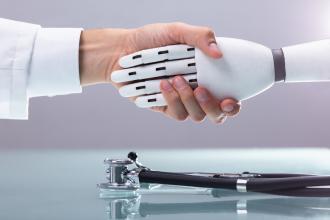Technology in seniors’ care
Few people who consider the future of health care can argue that the aging demographic poses both serious challenges and huge opportunities. Along with predicted shortages of health care workers and fiscal constraints, meeting the quadruple aim of health care (improved population health, better patient experience, better provider experience, and reduced cost) for a growing senior population will necessarily rely increasingly on existing and emerging technologies.
Few people who consider the future of health care can argue that the aging demographic poses both serious challenges and huge opportunities. Along with predicted shortages of health care workers and fiscal constraints, meeting the quadruple aim of health care (improved population health, better patient experience, better provider experience, and reduced cost) for a growing senior population will necessarily rely increasingly on existing and emerging technologies.
Technological advances in health care are abundant, ranging from artificial intelligence, which will, for example, create patient-specific care plans based on multiple parameters, to virtual and augmented reality, which will allow trainees to learn procedures safely before having contact with patients. Tricorders for rapid bedside diagnostics and tailor-made drug regimens using gene sequencing to guide pharmacologic choices are other looming technologies.
For improving elder care, technologies can be broadly divided into four categories: managing patient data, disease self-management, monitoring patient-specific medical or risk factors, and providing care to the patient.
In the area of patient information, BC has one of the highest rates of electronic medical record (EMR) adoption in Canada,[1] and digital records are improving clinical care and workflows as well as communication between doctor and patient/caregiver and among health care providers. The future holds improved communications accessed from and stored within the EMR. EMRs may also be the repository of patients’ health data as collected by various monitors.
In terms of self-care, which for elders often means the “circle of care,” a growing number of apps are available for smart phones and tablets that are user-friendly and provide useful information, as would a reference book. Apps can also monitor functions like sleep and heart rate and provide reminders to take medications.
These apps are relatively passive and require a certain degree of patient (or caregiver) involvement. While seniors are increasingly computer savvy,[2] those with sensory, cognitive, or functional impairment may not themselves be able to use these technologies.
Next is the realm of remote monitoring, including electronic sensors and video surveillance. The so-called Internet of Things will offer a host of home-based sensors to track such things as activities and medication compliance. Seniors’ homes may have device monitoring—Is the fridge door being opened often enough? Are medications being popped out of blister packs? Already available, Smart Blisters have an electrical current that is interrupted when the foil of a blister is torn. To be effective, these sensors and video monitoring require that someone, either the patient or, more likely, an involved caregiver, is notified when activities don’t meet predetermined thresholds. Since frail and demented elders are at high risk of falling and wandering, sensors in the floor and GPS trackers will be used to monitor seniors and notify caregivers of problematic events. These technologies, in combination, may enhance the health and safety of seniors, but it will be at the cost of loss of privacy and autonomy. The ability for seniors to understand and consent to the use of such monitoring systems may also be questionable.
Perhaps the most promising and, at the same time, ethically challenging technologies involve patient care. So-called care robots are technological devices integrated into care practices. They may offer indirect or direct care to patients and, in the latter, they may assist with physical care, like bathing, or be used more for psychosocial care such as companionship. It is argued that robots hold the promise of mitigating a shortage of health care workers and enhancing the autonomy of elders.[3] At the same time there are concerns that robots will diminish the moral quality and standard of care.[4] As assistive technology expands, so does the field of robo-ethics. Sharkey and Sharkey[5] highlight areas of concern in robotic elder care—reduction in human contact, loss of privacy, loss of personal liberty, loss of control, deception, and objectification. This suggests that care benefits should be thoughtfully weighed against the ethical costs.
—Jay Slater, MD
Geriatrics and Palliative Care Committee
hidden
This article is the opinion of the Geriatrics and Palliative Care Committee, a subcommittee of Doctors of BC’s Council on Health Promotion, and is not necessarily the opinion of Doctors of BC. This article has not been peer reviewed by the BCMJ Editorial Board.
References
1. Collier R. National physician survey: EMR use at 75%. CMAJ 2015;187:E17-E18.
2. Anderson M, Perrin A. Pew Research Center. Tech adoption climbs among older adults. Accessed 19 December 2017. www.pewinternet.org/2017/05/17/tech-adoption-climbs-among-older-adults.
3. Santoni de Sio F, van Wynsberghe A. When should we use care robots? The nature-of-activities approach. Sci Eng Ethics 2016;22:1745-1760.
4. Vallor S. Carebots and caregivers: Sustaining the ethical ideal of care in the twenty-first century. Philos Technol 2011;24:251-268.
5. Sharkey A, Sharkey N. Granny and the robots: Ethical issues in robot care for the elderly. Ethics Inf Technol 2012;14:27-40.

